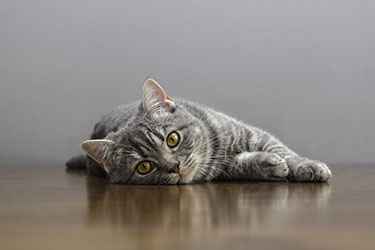Telling First-Time Cat Owners about Hairballs

New cat owners are probably familiar with litter boxes, cat food, and ways to keep a cat from clawing furniture. However, they always seem to be surprised by something most cats have in common – hairballs!
Oftentimes, they’ll call your office in a panic. “My cat is vomiting!” they may exclaim. “Should I bring him in?”
How do you, as the first contact clients have with your practice, both soothe and inform them? Here’s some information to pass on to panicky, first-time cat owners.
Basic Cat Hairball Facts for First-Time Cat Owners
What Is a Hairball?
Cats are fastidious groomers. When they clean, they lick to wet their fur with saliva, and then finish by licking it dry. Any dirt or loose hairs on their coat get picked up by tiny, barb-like spines found on the surface of their tongue. Hairballs form from the swallowed hair.
What to Expect When a Cat Has a Hairball
While the majority of the hair a cat swallows will move through the digestive tract and be passed in its stool, a cat with a hairball that forms in its stomach will try to vomit. Watching a cat expel a hairball is not pleasant.
Clients may benefit from knowing what to expect should their pet begin to rid itself of a hairball. For instance, the animal may be observed to:
- Position its body close to the ground with legs tucked under and neck outstretched
- Vocalize with a low cry
- Gag
- Heave
- Retch
- Quickly vomit up the hairball.
Indications of a Medical Problem
If the animal can’t pass or vomit a hairball, the ingested hair may build up and form a blockage in its stomach and/or in its intestines. If this happens, clients need to know that their pet is in an emergency situation that requires immediate veterinary attention.
The warning signs that indicate a potentially life-threatening blockage could include:
- Loss of appetite
- Lethargy
- Constipation
- Diarrhea
- On-going:
- Gagging
- Heaving
- Retching
- Attempting to vomit, but without producing a hairball.
Hairball Prevention
There is no way to completely prevent a cat from having hairballs, but clients may be relieved to know that there are steps they can take to reduce the likelihood that they will form.
#1. Routinely groom the animal
Even when a cat looks clean and sleek, there is still a good chance that its coat contains shed or loose hair. Establishing a regular brushing regimen will benefit both animal and owner by:
- Reducing the quantity of hair that could be licked off and swallowed to eventually form into a hairball
- Cutting down on the amount of hair that gets shed in and around the home
- Keeping the animal’s coat sleek, healthy, and free of parasites.
Some cats do not like being groomed and will fight against being having their coat brushed. Clients with animals that are unaccustomed to being handled or with tangled and matted coats may benefit from knowing they can contact a professional groomer for advice and help.
#2. Provide dietary supplements
While the best way to reduce their cat’s chance of forming hairballs is to regularly groom the animal, advise clients that the following preventives can also be administered:
- Lubricants are mild petroleum-based laxatives that lubricate and help the ingested hair slide through the intestinal tract. They are often infused with flavor to appeal to the animal. Many are made to be eaten or licked off of the paw. Because of their tendency to interfere with vitamin absorption, some petroleum-based laxatives are made with extra fat-soluble vitamins A, D, E, and K.
- High-fiber bulk additives increase the amount of fiber in an animal’s daily diet, reducing the incidence of hairballs by keeping the cat’s intestinal tract moving normally. High-fiber supplements can be added to the animal’s daily diet through treats, tablets, and powders. Commercial “hairball formula” cat foods offer another convenient way to increase the amount of a cat’s daily fiber intake.
When a cat suffers from frequent hairballs, clients should first focus on providing for its grooming needs. If this offers the animal no relief, their next step is to talk with their veterinarian for advice on applying alternative methods for hairball prevention.
Your Covetrus representative can provide additional information on caring for cats, contact us at 855.724.3461 .
Careers
Are you looking for a place to let your talents shine? At Covetrus, we help our practitioner customers better serve their patients and take pride in providing the best customer experience possible. Search our open positions to see our available opportunities.
Newsletter
Stay current with what’s going on with Covetrus, subscribe to receive our newsletter and email communications. Subscribers will receive the latest information in practice management, sales and marketing, animal health, and more.


Leave a comment